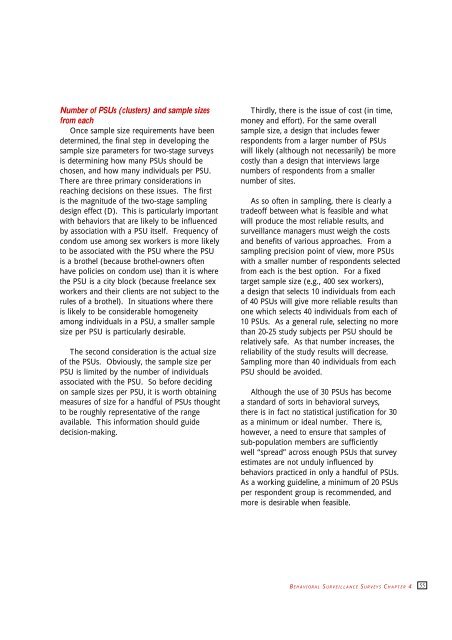Behavioural Surveillance Surveys - The Wisdom of Whores
Behavioural Surveillance Surveys - The Wisdom of Whores
Behavioural Surveillance Surveys - The Wisdom of Whores
You also want an ePaper? Increase the reach of your titles
YUMPU automatically turns print PDFs into web optimized ePapers that Google loves.
Number <strong>of</strong> PSUs (clusters) and sample sizes<br />
from each<br />
Once sample size requirements have been<br />
determined, the final step in developing the<br />
sample size parameters for two-stage surveys<br />
is determining how many PSUs should be<br />
chosen, and how many individuals per PSU.<br />
<strong>The</strong>re are three primary considerations in<br />
reaching decisions on these issues. <strong>The</strong> first<br />
is the magnitude <strong>of</strong> the two-stage sampling<br />
design effect (D). This is particularly important<br />
with behaviors that are likely to be influenced<br />
by association with a PSU itself. Frequency <strong>of</strong><br />
condom use among sex workers is more likely<br />
to be associated with the PSU where the PSU<br />
is a brothel (because brothel-owners <strong>of</strong>ten<br />
have policies on condom use) than it is where<br />
the PSU is a city block (because freelance sex<br />
workers and their clients are not subject to the<br />
rules <strong>of</strong> a brothel). In situations where there<br />
is likely to be considerable homogeneity<br />
among individuals in a PSU, a smaller sample<br />
size per PSU is particularly desirable.<br />
<strong>The</strong> second consideration is the actual size<br />
<strong>of</strong> the PSUs. Obviously, the sample size per<br />
PSU is limited by the number <strong>of</strong> individuals<br />
associated with the PSU. So before deciding<br />
on sample sizes per PSU, it is worth obtaining<br />
measures <strong>of</strong> size for a handful <strong>of</strong> PSUs thought<br />
to be roughly representative <strong>of</strong> the range<br />
available. This information should guide<br />
decision-making.<br />
Thirdly, there is the issue <strong>of</strong> cost (in time,<br />
money and effort). For the same overall<br />
sample size, a design that includes fewer<br />
respondents from a larger number <strong>of</strong> PSUs<br />
will likely (although not necessarily) be more<br />
costly than a design that interviews large<br />
numbers <strong>of</strong> respondents from a smaller<br />
number <strong>of</strong> sites.<br />
As so <strong>of</strong>ten in sampling, there is clearly a<br />
trade<strong>of</strong>f between what is feasible and what<br />
will produce the most reliable results, and<br />
surveillance managers must weigh the costs<br />
and benefits <strong>of</strong> various approaches. From a<br />
sampling precision point <strong>of</strong> view, more PSUs<br />
with a smaller number <strong>of</strong> respondents selected<br />
from each is the best option. For a fixed<br />
target sample size (e.g., 400 sex workers),<br />
a design that selects 10 individuals from each<br />
<strong>of</strong> 40 PSUs will give more reliable results than<br />
one which selects 40 individuals from each <strong>of</strong><br />
10 PSUs. As a general rule, selecting no more<br />
than 20-25 study subjects per PSU should be<br />
relatively safe. As that number increases, the<br />
reliability <strong>of</strong> the study results will decrease.<br />
Sampling more than 40 individuals from each<br />
PSU should be avoided.<br />
Although the use <strong>of</strong> 30 PSUs has become<br />
a standard <strong>of</strong> sorts in behavioral surveys,<br />
there is in fact no statistical justification for 30<br />
as a minimum or ideal number. <strong>The</strong>re is,<br />
however, a need to ensure that samples <strong>of</strong><br />
sub-population members are sufficiently<br />
well “spread” across enough PSUs that survey<br />
estimates are not unduly influenced by<br />
behaviors practiced in only a handful <strong>of</strong> PSUs.<br />
As a working guideline, a minimum <strong>of</strong> 20 PSUs<br />
per respondent group is recommended, and<br />
more is desirable when feasible.<br />
B EHAV I OR A L S U R V EI L L A NC E SURV EY S CHAPTER 4<br />
55










